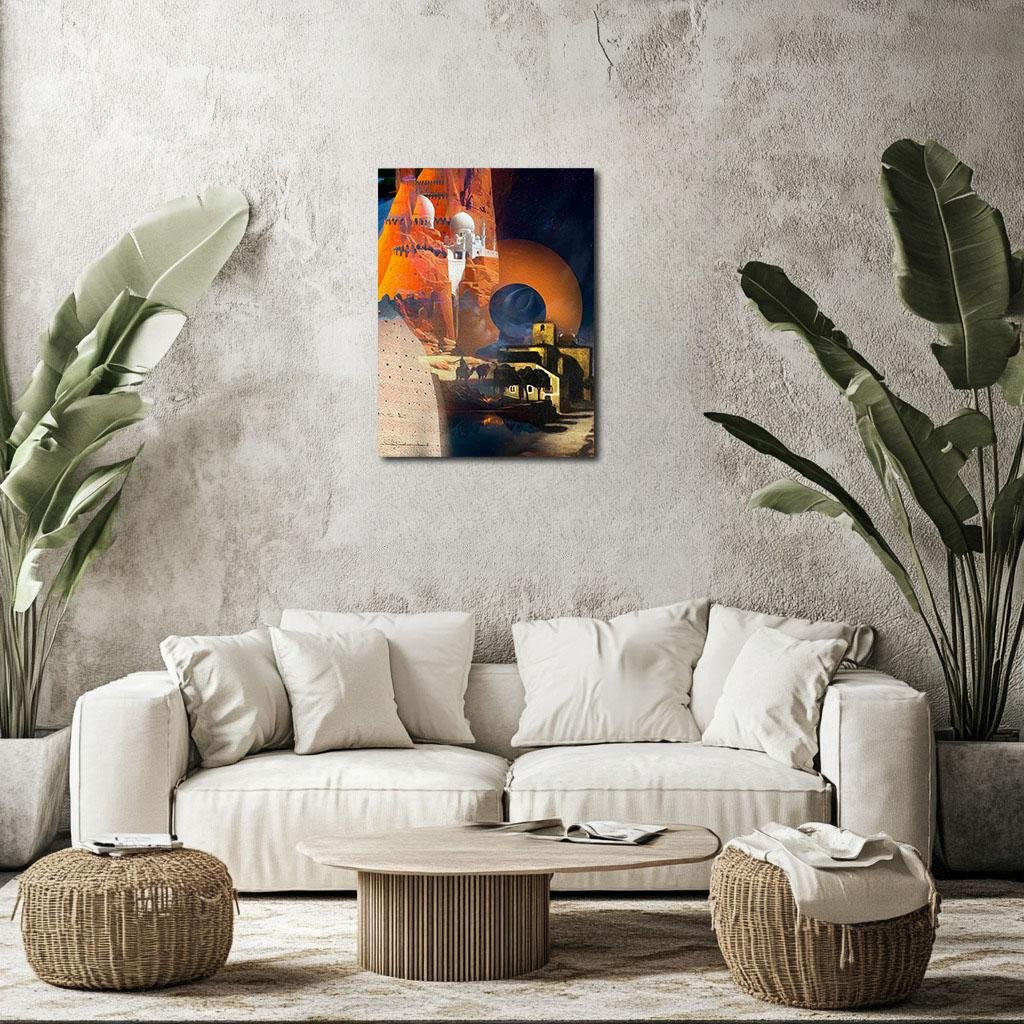Oasis of Stars: A Cosmic Reimagining of Avila’s Night
Oasis of Stars reimagines Diego Rivera’s Night Scene in Avila as a transcendent landscape where domed architecture meets galactic stillness. A glowing mosque rises from sunburnt cliffs into a dark sky ringed with planetary orbits, while a fortress in shadow reflects in a pool of stars. Warm saffron and orange hues blend with cosmic blues and silvers, balancing earth and cosmos, history and myth. Through surreal layering, this piece turns a Spanish town into a dreamlike portal—inviting the viewer to walk the line between memory, faith, and the infinite.
Please see Below for Details…
Hotline Order:
Mon - Fri: 07AM - 06PM
404-872-4663
This reimagining of Diego Rivera’s Night Scene in Avila unfolds not as a quiet Spanish night, but as a dreamlike pilgrimage across epochs and planets. Titled Oasis of Stars , the composition transcends the constraints of earthly geography, merging medieval Islamic architecture, cosmic phenomena, and desert echoes into one surreal continuum. It is less a view and more a portal—where caravan trails dissolve into galaxies, and domed cities rise like prayers etched into stone.
Rivera’s original mood of stillness and solitude is retained, but it is transfigured into something more mythic. At the core of this composition is a glowing white mosque perched against a sandstone cliff, its silhouette carved with precision into the heated walls of what feels like Mars, yet might be the heart of an ancient Sahel. Light and geometry blend into a sacred vertical ascent. Its minarets do not pierce the sky—they become sky, floating upward into a whirl of stardust and silence. This is not just a city; it is a celestial construct—built to be seen not by pilgrims, but by constellations.
Beneath it, a darker realm emerges. An old fortress clings to the edge of shadow, its walls dipped in indigo and clay. The still water below reflects stars and silence alike, as caravans of camels, mere silhouettes, move slowly across the frontier between time and void. This visual dialogue—between light and dark, between fire-tinted stone and the deep cosmos—carries the emotional core of the piece. Rivera’s interest in people, place, and transformation remains, but here it is reworked through the lens of surrealism and cosmic mysticism.
The color story of Oasis of Stars plays like a hymn written in radiant tension. The left of the composition is drenched in a spectrum of sunfire tones—saffron, tangerine, and rust—each evoking the spiritual heat of the desert and the wisdom embedded in stone. These colors pulse like living terrain, rich with stories, sacredness, and survival. Every shade of orange feels like it was sung into place by the desert wind.
As the gaze shifts rightward, the mood alters completely. There, deep celestial blues, soft coal grays, and lunar silver take over. The cosmos is rendered not with scientific precision but poetic intuition. The planet that floats behind the mosque—a black orb haloed by ochre and brown—feels both real and imagined. It could be a sun in eclipse, or a dying world reborn in shadow. This planetary element breaks perspective and time, anchoring the piece in an otherworldly now.
The use of black is intentional and sacred. It does not erase; it envelops. It creates mystery, like the sacred unknown of night prayer or the pause between desert songs. The black sky glitters with specks of hope, drawing the eye into the void rather than away from it.
There are earthly textures embedded in the bottom-left corner—stucco walls dotted with geometric holes, remnants of adobe culture. This texture anchors the divine, reminding us that Rivera always began with the material, with the real. These earthen textures give permission to the rest of the scene to ascend, providing balance between tactile and ethereal.
When I created Oasis of Stars , I imagined Rivera walking not through Avila, but through a dreamscape layered with histories—Moorish empires, Silk Road nights, and interplanetary faiths. I did not want to simply honor a place, but the idea of place as transcendence. The architecture, the shadows, the sky—each element became less about location and more about longing. This is a place of breath held under stars, of pilgrims unsure whether they walk toward memory or miracle.
In Rivera’s Avila, we saw a quiet city under a Spanish sky. In Oasis of Stars , the city is still quiet—but now, it listens for echoes from other worlds.
Add your review
Your email address will not be published. Required fields are marked *
Please login to write review!
Looks like there are no reviews yet.








